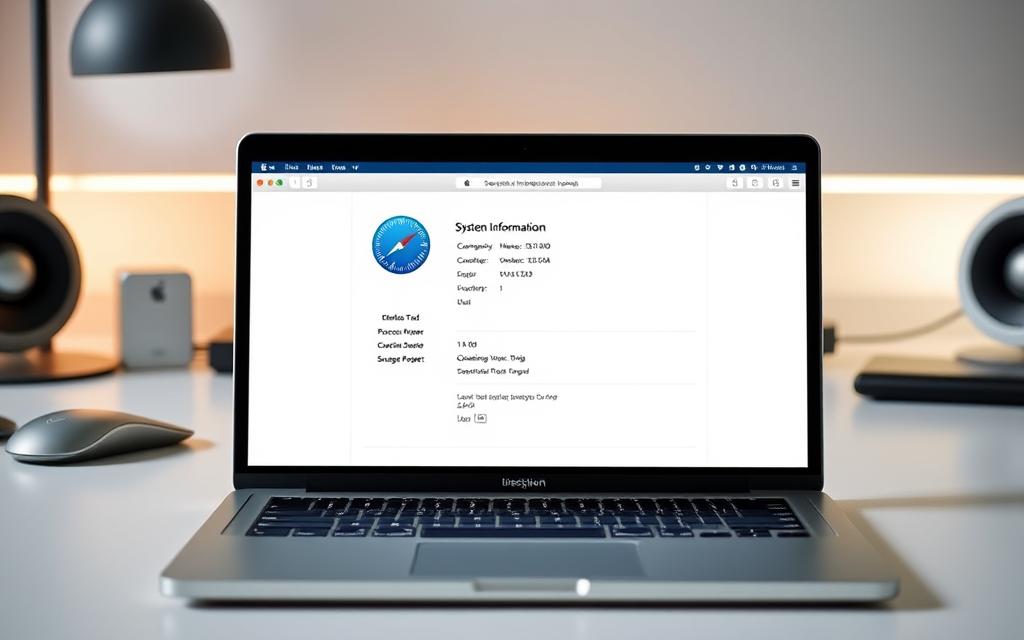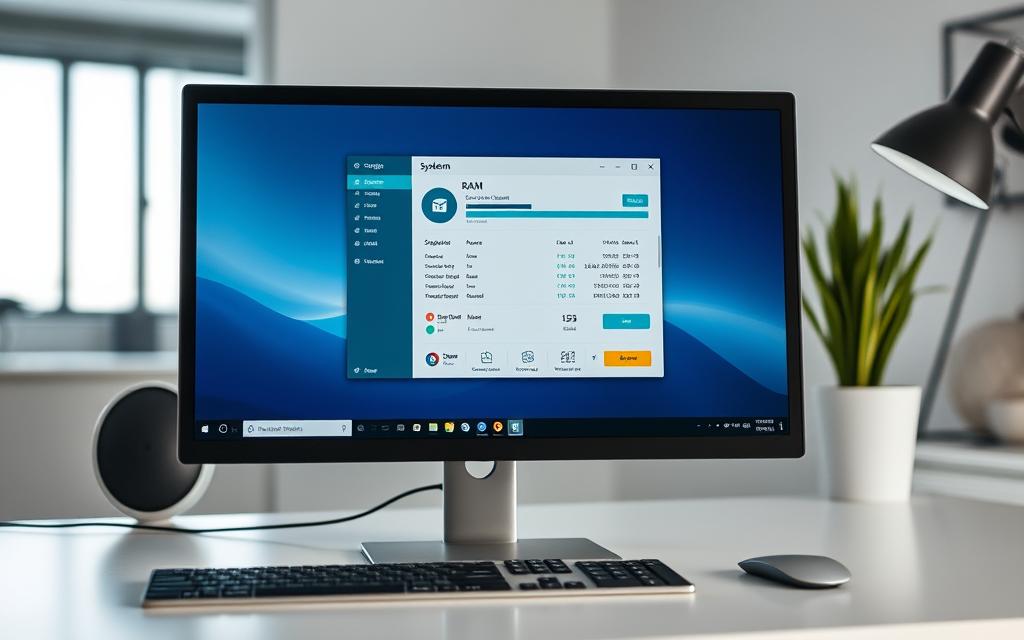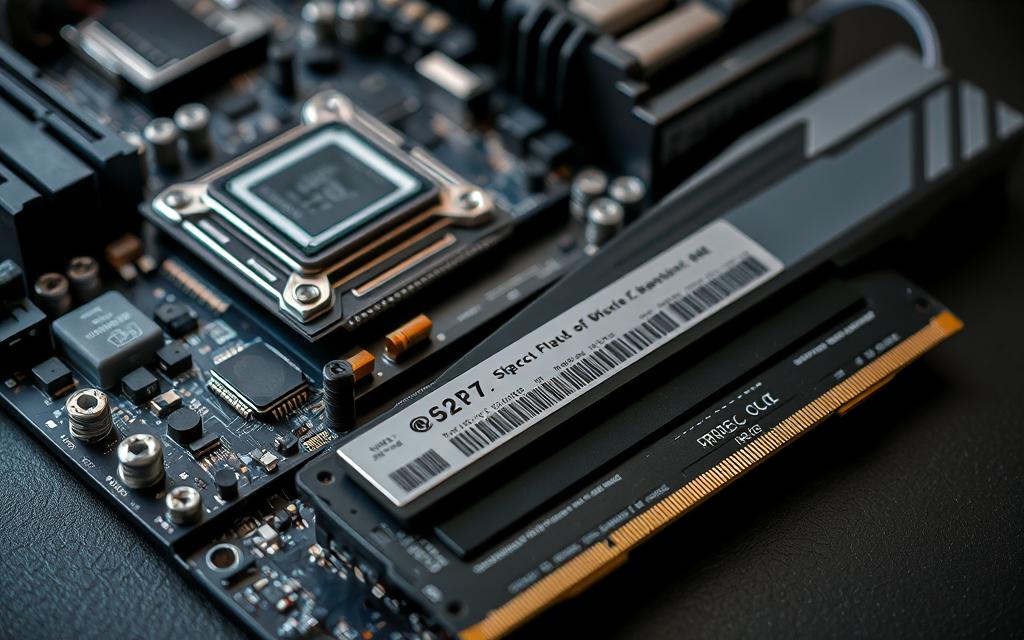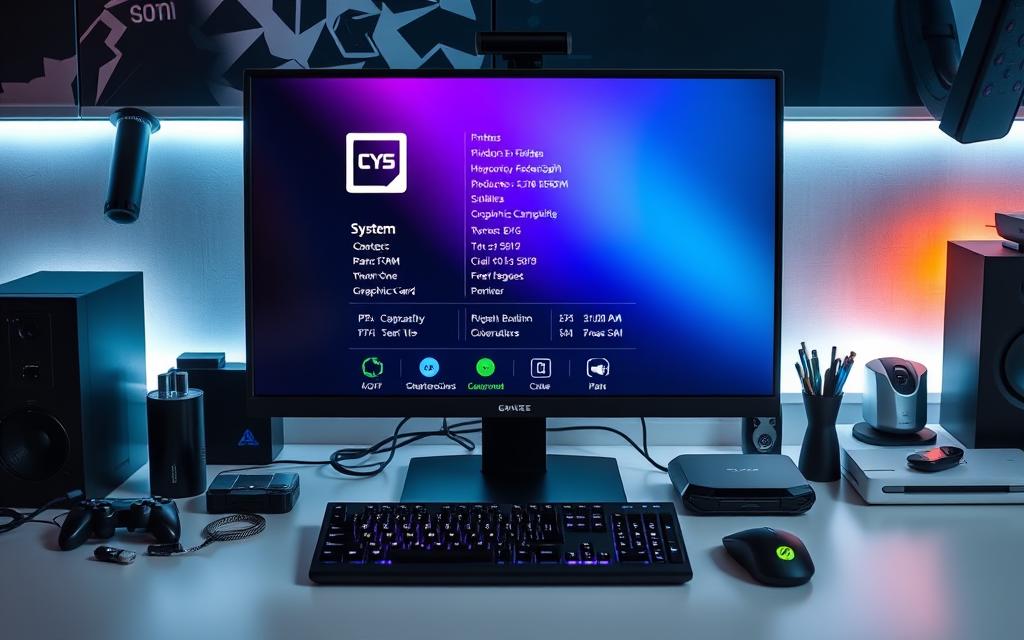How to Check Your Computer System Information: Quick and Easy Steps
To keep your computer running well, knowing its system information is key. This includes details about its hardware and software, like computer specs. It helps fix problems with programs and shows your system’s power.
Knowing your system’s info helps you see its strengths and limits. You can find out about your computer’s specs by visiting the system information page. It shows you the CPU, GPU, RAM, and storage, which affect how well your computer works.
It’s important to understand your computer’s system info for smooth operation. By checking your specs, you learn about your system’s power and what it can do. This knowledge helps you decide if you need to upgrade or change parts to boost performance.
Understanding Computer System Information
Knowing about a computer’s system information is key. It tells us what the computer can do and its limits. This includes the hardware like the processor, RAM, and storage, and the software like the operating system and programs. Windows Central says it’s important for spotting problems and improving the computer.
The processor is a main part of the computer. It can have one to ten cores, with ages from 1971 to 2017. For example, Intel Core i3, i5, i7, and i9 processors vary in power, with i9 being the strongest. RAM storage also varies, with 4GB being the least, 8GB good for everyday tasks, and 16GB or more needed for gaming and design.
Storage types like Hard Disk Drives (HDD) and Solid-State Drives (SSD) are also important. SSDs are faster and use less energy, making them better for quick data access. Knowing about these parts helps fix and improve computer performance.
What constitutes system information
System information covers the computer’s hardware and software. It includes the processor speed, which can be from 3.5 to 4.2 GHz, and the storage type. It also includes the operating system version and installed programs.
Why checking system specs matters
Checking system specs is crucial for knowing what the computer can do. It helps find problems and decide if upgrades or replacements are needed. By understanding system information, users can make their computer run better and more efficiently.
Basic components to identify
The key components to know are the processor, RAM, and storage devices. Knowing these and their specs is vital for fixing and improving computer performance. By checking system specs, users can ensure their computer is at its best and make smart upgrade or repair choices.
Essential Tools for Checking System Specifications
To find out what your computer can do, you need the right tools. The System Information tool, Device Manager, and the Settings app are key. They give you all the details about your computer’s system configuration.
For more in-depth checks, tools like Belarc Advisor, HWiNFO, and Free PC Audit are great. They let you see how fast your CPU, memory, and hard drives are. For example, HWiNFO shows you speeds, while Belarc Advisor gives a full report on your system configuration.
When picking a tool, think about a few things:
- Is it compatible with your operating system?
- Does it give you the details you need?
- Is it easy to use?
- Does it have extra features like monitoring and reporting?
Here’s a quick look at some top tools for checking system specs:
| Tool | Compatibility | Features |
|---|---|---|
| Belarc Advisor | Windows 11, 10, 8, 7, Vista, XP | Comprehensive report on system configuration |
| HWiNFO | Windows 11, 10, 8, 7 | Sensor status monitoring, detailed reports on hardware and software components |
| Free PC Audit | Windows 11, 10, 8, 7 | Portable, easy to use, provides detailed information on system configuration |
How to Check Computer System Information in Windows
Checking your computer’s system information in Windows is easy. You can use the System Information tool, also known as MSInfo32. Or, you can try the Control Panel method or Command Prompt commands.
In Windows, to find your device name, go to System > About in the Settings app. This info is key for fixing problems, upgrading, and keeping an eye on your computer’s performance.
Using System Information (MSInfo32)
The System Information tool gives you all the details about your computer’s parts and software. Just type “msinfo32” in the Windows search bar and pick the System Information app. It shows you your system’s specs, like the processor, memory, and operating system.
Accessing Control Panel Method
The Control Panel method lets you see basic system info. Go to the Control Panel, then System and Security, and click on System. You’ll get info on your processor, memory, and Windows version.
Knowing your computer’s specs is important for it to run smoothly and for fixing issues. By using these methods, you can easily check and review your Windows system information.
| Method | Description |
|---|---|
| System Information (MSInfo32) | Provides comprehensive details about hardware and software components |
| Control Panel Method | Offers basic system information, including processor, memory, and Windows version |
| Command Prompt Commands | Allows for detailed system information using specific commands |
Accessing System Information on Mac Computers
For Mac users, getting system information is easy. Just go to “About This Mac” from the Apple menu. You’ll find basic details about your Mac there. For more, like warranty info and system reports, check the General settings. You can find more help on the official Apple support page.
System Information on Mac gives a full view of your computer’s hardware and software. It shows model name, processor details, memory information, and serial number. It’s all sorted into sections like Audio, Bluetooth, and Storage, making it simple to find what you need.

Using About This Mac
The “About This Mac” option gives a quick look at your Mac’s system info. You can see the macOS version, processor, and memory. It also has detailed reports on your system’s hardware and software.
Terminal Commands for Detailed Information
For those who like to dig deeper, Terminal commands are the way to go. They let you see system logs, network settings, and hardware specs. Using these commands can help you understand your Mac better and fix problems more easily.
| Category | Description |
|---|---|
| Hardware | Model name, processor details, memory information, serial number |
| Software | macOS version, installed program version numbers, font details, startup items |
| Network | Ethernet, Wi-Fi components, Firewall status, connection information |
By checking system information on your Mac, you can learn more about your computer. Whether you use “About This Mac” or Terminal commands, you’ll get useful insights into your Mac’s system.
Checking Your Computer’s Hardware Components
Ensuring your computer works well is key. You need to check its hardware parts. These include the processor, RAM, storage, and graphics card. You can use the Task Manager or System Information to do this.
The processor type, like Intel Core i7, affects your computer’s power. Overclocking a CPU can make it faster but also risk overheating. For those who design graphics or play games, the GPU model matters a lot.
Here are some important parts to check:
- Processor: Intel Core i7, i5, or i3
- RAM: 8GB or more for the best performance
- GPU: AMD or NVIDIA for graphic designers and gamers
- Storage: Solid-state drives for quicker speeds
Updating graphics drivers can make your GPU work better. Also, adding more RAM can help your computer run smoother and handle more tasks. You can use the Windows + X keys to open the Task Manager and see CPU, RAM, and GPU usage.
Regularly checking your computer’s hardware helps find and fix problems. This ensures your computer works well and efficiently.
Analysing Your Operating System Details
Understanding your computer’s capabilities is key. Knowing your Windows version, build numbers, and system architecture is crucial. This info ensures software and hardware work well together, helping fix problems and boost performance.
To understand your operating system, you need to look at the software details and system configuration. Check the Windows version in the System Properties section. Also, find the build numbers and system architecture in the System Information section.
Windows Version Identification
Finding your Windows version is vital for software compatibility. Press the Windows key + R and type “winver” in the Run dialog box. This shows your Windows version, build number, and system architecture.
Build Numbers and Updates
Build numbers and updates are also key. Go to the Settings app and click on “Update & Security”. Here, you’ll see the current build number and any updates available.
System Architecture Details
Details like processor type and RAM amount are important. Check these in the System Properties section or with tools like Speccy.
By analysing your operating system details, you learn more about your computer. This makes troubleshooting and improving performance easier.
Third-Party Applications for System Information
Having the right tools is key when troubleshooting system issues. Third-party apps offer detailed system info and troubleshooting tools. This helps users find and fix problems fast. Tools like CPU-Z, GPU-Z, and Speccy are very popular.
These apps have many features. They include hardware monitoring, software analysis, and benchmarking. For instance, CPU-Z and GPU-Z give detailed info on your system’s processor and graphics card. They show clock speed, voltage levels, and temperature. This info is great for fixing performance and stability issues.
A list of top system information software includes:
- Speccy
- Everest Home Edition
- Wise System Monitor
- HWiNFO
- CPU-Z and GPU-Z
These tools help users spot potential problems. They give valuable insights for fixing system issues.
Using these third-party apps helps users understand their system better. It makes troubleshooting and fixing issues easier. With the right tools and info, users can make their system run better and more efficiently.
Understanding RAM and Storage Information
Understanding system information about RAM and storage is key. RAM, or Random Access Memory, holds data and apps temporarily while your computer runs. More RAM means you can run more apps at once.
Storage is where your computer keeps data forever. This includes hard disk drives (HDDs), solid-state drives (SSDs), and more. The type and amount of storage affects your computer’s speed and how much you can store. For instance, SSDs are faster than HDDs because they use circuits, not mechanical parts.
Important things to think about with RAM and storage are:
- RAM capacity: Measured in gigabytes (GB) or terabytes (TB).
- Storage type: Includes HDDs, SSDs, and other devices.
- Storage capacity: Can be from a few hundred GB to several terabytes or even petabytes.

When it comes to system information, remember that RAM loses data when turned off. Storage keeps data even when off. Also, different apps need different amounts of memory. For example, video editing or gaming needs more RAM for the best performance.
| RAM Type | Capacity | Transfer Rate |
|---|---|---|
| DDR4 | Up to 64GB | 25.6GB/s |
| DDR5 | Up to 128GB | 51.2GB/s |
Graphics Card and Display Properties
When it comes to computer specifications, the graphics card and display are key. They ensure smooth graphics. The graphics card has a GPU model, memory, and bandwidth. Knowing these is vital for top performance, especially in gaming and video editing.
The display’s properties include resolution and refresh rates. A high refresh rate is important for gamers. For example, a 4K resolution with a 60Hz refresh rate makes gaming smooth.
To see these details, users can use the Device Manager or System Information app. The DirectX Diagnostic Tool also helps, giving a detailed look at graphics devices and drivers. Keeping graphics drivers up to date is crucial for performance and security. Tools like Avast Driver Updater can help with this.
NVIDIA and AMD are well-known GPU makers. They offer models like the NVIDIA GeForce RTX 3080 Ti and AMD Radeon graphics. When picking a laptop, searching for one by graphics card on the HP India Store is a good idea. Knowing about graphics and display helps users get the best performance for gaming and video editing.
| GPU Maker | GPU Model | Memory |
|---|---|---|
| NVIDIA | GeForce RTX 3080 Ti | 12GB |
| AMD | Radeon graphics | 8GB |
Network and Connection Details
To understand your computer’s network and connection details, it’s key to look at the hardware components that help it talk to other devices and the internet. The network adapter, Wi-Fi settings, and Ethernet settings are very important. By checking these, you can spot problems and make your network better.
Fixing network issues is a big part of this. The hardware components of your computer, like the network adapter, are crucial. By looking at the network adapter’s settings, you can solve connection problems and make your network better.
Some important network and connection details to check include:
- Network adapter settings
- Wi-Fi connection settings
- Ethernet settings
- IP configuration
- DNS server settings
You can find these details in different ways, like the Control Panel, Command Prompt, or third-party apps. By knowing and adjusting these settings, you can make your network faster and more reliable.

In conclusion, checking your computer’s network and connection details is very important for good performance and reliability. By understanding the hardware components and setting up the right settings, you can fix problems and enhance your network experience.
Troubleshooting System Information Issues
When you face system information problems, it’s key to be logical and methodical. Focus on troubleshooting and system configuration. This means finding the main cause and fixing it. Issues like “Access denied” or “System information not available” can be fixed with simple steps.
Checking the system configuration is crucial. Look for wrong settings or old drivers. Also, keep your system up to date with software updates and disk cleanup. This way, you can avoid many problems. By being proactive, you can fix issues fast, reducing downtime and keeping your system running well.
Common Error Messages and Solutions
Here are some common errors and how to fix them:
- Access denied: Check your user permissions and make sure you’re using the right login details.
- System information not available: Make sure the system information tool is installed and set up right.
By following these steps and being proactive, you can solve system information problems quickly. This ensures your system works smoothly and efficiently.
Conclusion
Knowing your computer’s system information is key to keeping it running smoothly. By checking your system information and computer specifications often, you can spot any issues. This helps you decide when to upgrade or replace parts.
This guide has shown you how to find and understand your computer’s details. You now know how to check the processor, memory, and more. It doesn’t matter if you use a Windows or Mac computer. You’re now ready to manage your device’s performance and fix any problems.
Keeping up with your computer’s specs is important for its health and life span. By using what you’ve learned, you can improve your computer’s performance. This way, you’ll have a better and more enjoyable computing experience.
FAQ
What constitutes computer system information?
Computer system information includes details about the computer’s parts. This includes the processor, RAM, storage, and operating system. It also covers other important specs.
Why is checking system specifications important?
It’s key to check your computer’s specs to find issues or upgrade parts. This ensures your computer works well and efficiently. It shows what your computer can do and its limits.
What are the basic hardware components to identify?
You should know about the processor, RAM, and storage. These are vital for understanding your computer’s performance and what it can do.
What tools can I use to check system specifications on Windows?
On Windows, you can use System Information (MSInfo32), the Device Manager, and the Settings app. These tools give detailed info on your computer’s hardware and software.
How can I check system information on Mac computers?
On Macs, you can use “About This Mac” for basic info. Or, Terminal commands for more detailed system info.
What third-party applications can provide more detailed system information?
Tools like CPU-Z, GPU-Z, and Speccy offer detailed info on your computer’s hardware and performance. They are popular for this purpose.
How can I troubleshoot system information access issues?
If you face issues like “Access denied” or “System information not available,” try troubleshooting. Run tools as an admin or check for software or security settings blocking access.















